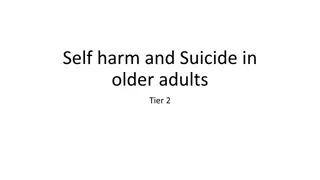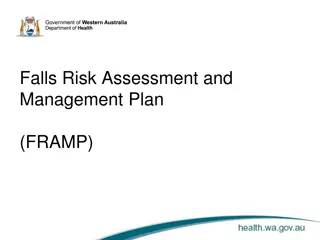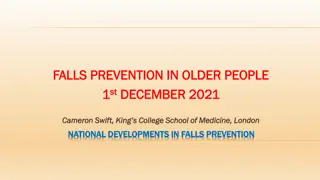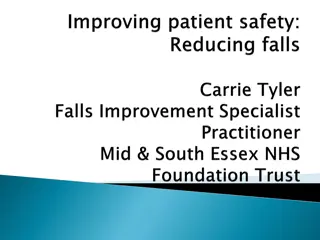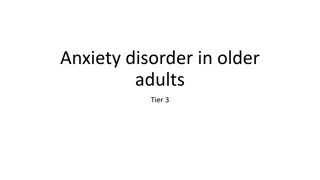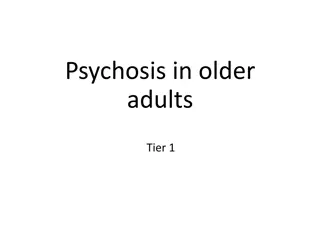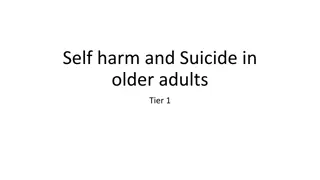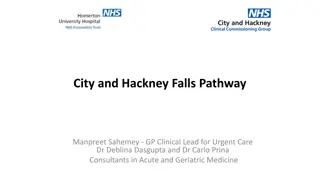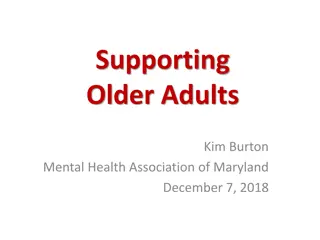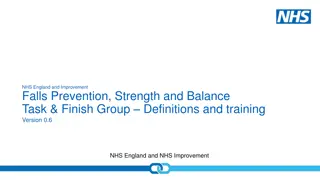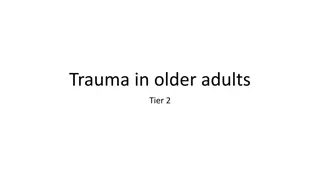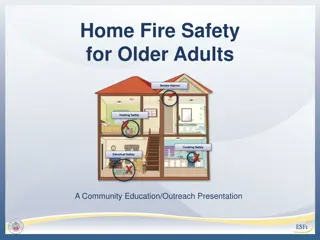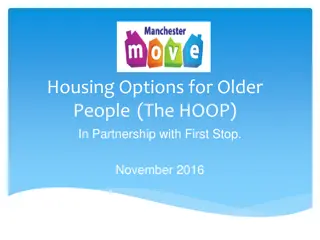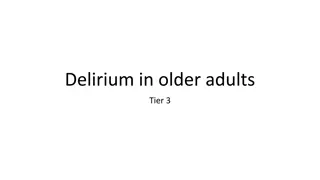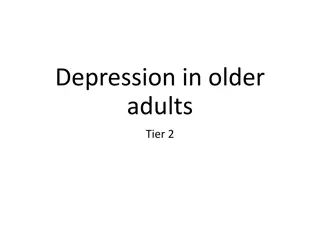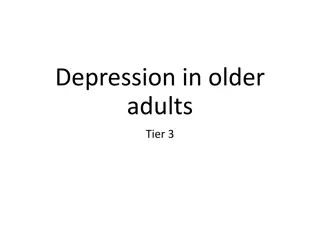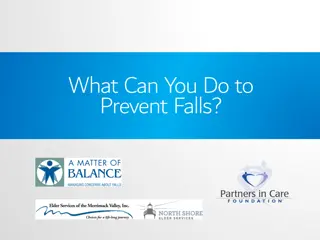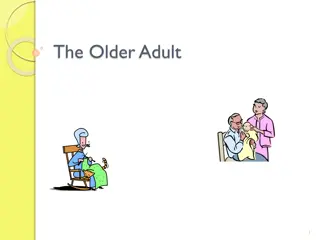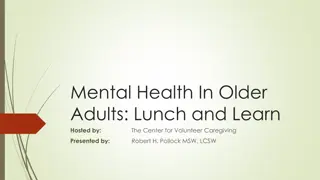Falls in Older Adults: Risk Factors and Assessment
Falls in older adults are a common and serious issue, leading to injuries and fatalities. This content covers the prevalence of falls, screening questions, risk factors, and a multifactorial fall assessment approach. Understanding these aspects is crucial for healthcare professionals to effectively address fall prevention and management in older individuals.
Download Presentation

Please find below an Image/Link to download the presentation.
The content on the website is provided AS IS for your information and personal use only. It may not be sold, licensed, or shared on other websites without obtaining consent from the author.If you encounter any issues during the download, it is possible that the publisher has removed the file from their server.
You are allowed to download the files provided on this website for personal or commercial use, subject to the condition that they are used lawfully. All files are the property of their respective owners.
The content on the website is provided AS IS for your information and personal use only. It may not be sold, licensed, or shared on other websites without obtaining consent from the author.
E N D
Presentation Transcript
Falls Falls David B. Reuben, MD Archstone Foundation Chair and Professor David Geffen School of Medicine at UCLA
DISCLOSURES DISCLOSURES None of the faculty, planners, speakers, providers nor CME committee has any relevant financial relationships with commercial interest There is no commercial support for this CME activity
What We What We W Will ill C Cover over Background Screening for falls Reducing individual risk factors Questions 3
Falls are Common Falls are Common 1 in 3 people over the age of 65 years falls each year Falls are the leading injury among older adults: non fatal and fatal leading cause of
Screening Screening Have you fallen 2 or more times in the past year? (incidence Rate Ratio=1.56) Have you fallen and hurt yourself in the past year? (Incidence Rate Ratio=1.41) Are you afraid that you might fall because of balance or walking problems? (referent group) Jennings LA et al. Am J Manag Care 2015 Sep 1;21(9):e519-26.
Risk factors for falls Risk factors for falls M Most falls are caused by multiple risk factors ost falls are caused by multiple risk factors Modifiable Risks Modifiable Risks Non Non- -Modifiable Modifiable Risks Risks Lower body weakness Balance changes Gait changes Medication risk Postural Hypotension Vision impairment Problems with feet or shoes Home Hazards/ Decreased Safety Age History of falls
Multifactorial Fall Assessment Multifactorial Fall Assessment Focused history Activity patterns and preferences History of falls History of relevant health issues Medication use Physical examination Gait, balance, mobility Postural pulse and blood pressure Visual acuity reviewed Examination of feet and footwear
VISIT FORM: FALLS/MOBILITY PROBLEMS Reason for Visit: History of Present Illness: 1. If patient fell, date of last fall: __________________ 2. Circumstances of fall: Loss of consciousness . Tripped/stumbled over something .. Lightheadedness/palpitations . Unable to get up within 5 minutes .. Needed assistance to get up .. 3. Psychotropic medications (specify): Neuroleptics: ____________________ Benzodiazepines: ________________ Antidepressants: _________________ 4. 2 or more drinks alcohol each day .. Examination: 1. Lying: BP: _____/_____ Pulse: _____ Standing: BP: _____/_____ Pulse: _____ 3. Cognition: 3-Item recall: Fall since last visit (or in last year, if new patient) Fear of falling, balance/trouble walking 5. Uses device for mobility: Cane .. Walker .... Wheelchair Other, specify: ____________________ 6. Other conditions (e.g., Parkinson s, CVA, cardiac, neuropathy, severe OA), specify: ________________________________ 7. Vision: Noticed recent vision change . Eye exam in past year . NO YES NO YES 2. If NO eye exam in past year, Visual Acuity: OS: 20/_____ FAIL If FAIL Cognitive status: OD: 20/_____ OU: 20/_____ PASS 4. Gait: Abnormal if: -Hesitant start NORMAL ABNORMAL -Heels do not clear toes of other foot -Heels do not clear floor -Path deviates NO If indicated: Can pick up penny off floor .. Resistance to nudge . -Broad-based gait -Extended arms 5. Balance: Side-by-side, stable 10 sec . Semi-tandem,stable 10 sec .. Full tandem,stable 10 sec .. YES NO YES 6. Neuromuscular: Quad strength: Can rise from chair w/o using arms If indicated, hip ROM and knee exam: YES NO Rigidity (e.g., cogwheeling). Bradykinesia .. Tremor NO YES Impression: Diagnosis/Treatment Plan: Lab/Tests: EKG Holter monitoring Other: _________________ Strength problem Balance problem Parkinsonism Severe hip/knee OA Other: ______________ Treatment: Patient education handout: Falls Home safety checklist Strength/balance exercises: Referral for PT Assistive device: __________________________________ Referral for home safety inspection/modifications Change in medication(s): ___________________________ Referral for eye exam Cardiology consult Neurology consult Upper body Lower body Community resources Community exercise program Other: _________________________________________ Provider s Signature_________________________________________ Date of Visit______________ Patient Name: ____________________________ Med. Rec. # ______________________________ (Medical Group logo here) Date of Birth: _____________________________ PCP: ____________________________________
Multifactorial Solutions Multifactorial Solutions 1. Reduce high-risk medications Minimize alcohol use 2. Treat postural hypotension 3. Correct vision changes 4. Wear safe footwear 5. Treat Osteoporosis/ Calcium & Vitamin D 6. Optimize home environment 7. Build leg strength and balance Maintain practice of Balance/ Strength exercises
Medication Risks Medication Risks
Reducing Reducing Medication Medication- -related Risks of Falling Risks of Falling related Reduce the number and/or dosage of certain types of medications: Drugs causing symptoms Drugs that the patient would like to stop Drugs without compelling clinical indications FRIDs 13
Bad Fall Risk Increasing Drugs Bad Fall Risk Increasing Drugs Drug Class Drug Class Examples Examples Psychotropic drugs Sedative/hypnotics Ambien, Ativan Antidepressants Lexapro, Effexor Antipsychotics Risperdal, Zyprexa Opioids First-generation antihistamines Skeletal muscle relaxants Long-acting hypoglycemics Alcohol (> 1 drink/d) Codeine, morphine Benadryl, Tavist Robaxin, Flexeril Chlorpropamide, Glyburide Beer, wine, whiskey, mixed drinks 14
Strategies for De Strategies for De- -escalating Medications Medications escalating Use alternative treatments. Decrease the dose slowly ( de-escalate ) over time, because: Original symptoms may recur when dose is lowered Withdrawal symptoms may occur. 15
An Example An Example De Benzodiazepines Benzodiazepines De- -escalating escalating Symptom recurrence Withdrawal symptoms Risk factors for withdrawal Use for more than one year Use of high doses Use of benzos with short or intermediate half- lives 16
Barriers to Changing Medications Barriers to Changing Medications Prescribers AND Patients encounter two barriers: 1) Lack of awareness of the falls risk of a medication Comment: I ve been taking this for a long time. Response: The way the body handles and responds to medications changes with age, often resulting in higher levels of drug in the body and more side effects even though you ve been taking the same dose for years. 2) Fear of unfavorable effects of reducing meds 17
Strategies for Success with Drug Strategies for Success with Drug Reduction Reduction 1. Focus on patients at greatest risk of falling. 2. Decrease the drugs that most often increase fall risk. 3. Target drugs that have no current indication. 4. Utilize field-tested de-escalation protocols. 5. De-escalate slowly over an extended period under the supervision of a single clinician/team. 6. Celebrate success: smaller doses reduce risk (even if the patient can t stop using the drug entirely). 18
Postural Hypotension Postural Hypotension
Definition Definition Postural Hypotension A systolic BP drop of 20+ mmHg OR Systolic BP < 90 mmHg when standing. Pulse does not increase when BP drops 20+ mmHg Symptoms upon standing May occur with or without postural hypotension 20
Postural Hypotension Postural Hypotension If present and symptoms, treat If present and no symptoms, education about getting up, consider treatment If absent and symptoms, education about getting up and recheck in a few weeks If absent and no symptoms, monitor
Postural Hypotension Treatment Postural Hypotension Treatment Assess for medication cause, consider alternative treatment If dehydrate, re-hydrate, if not increase salt intake if no contraindications Consider medium compression stockings if ABI>0.8 If continued refractory, consider fludrocortisone or midodrine
Vision Problems Vision Problems
Visual Impairment and Fall Risk Visual Impairment and Fall Risk Three types of visual impairment can contribute to the risk of falling: - Decreased visual acuity (normal aging and due to cataracts, ARMD, glaucoma, diabetic retinopathy) - Impaired contrast sensitivity (normal with aging and multifocal glasses may have impaired contrast sensitivity and depth perception at the bottom of the visual field) - Reduced visual fields (stroke, glaucoma, ARMD) 24
Visual impairment Visual impairment If no eye exam in past year, refer If bilateral vision acuity 20/70 or worse, home safety evaluation If active outdoors and using multifocal glasses, refer to eye doctor If cataract, refer to eye doctor for possible surgery
Unsafe Feet and Footwear Unsafe Feet and Footwear 26
Footwear Problems Footwear Problems Footwear-related risk factors for falls include: Walking barefoot or in slippers or socks Wearing shoes that have: inadequate fixation (i.e., no laces, straps or buckle) tall and/or narrow heels soles that are smooth, thick or/and soft
Foot and Footwear Problems Foot and Footwear Problems If foot numbness, work up for peripheral neuropathy If pain, deformity, abnormal nails or skin, diagnosis of diabetes, consider referral to podiatrist If footwear concerns, eduation and consider referral to orthotist for inserts or safer shoes
Osteoporosis Osteoporosis
Fractures Fractures The vast majority of fractures are due to combination of two factors Forceful impact on a bone Minimal trauma (standing height or less) Major trauma Low bone strength, usually due to osteoporosis
Osteoporosis definitions Osteoporosis definitions Established osteoporosis: occurrence of a minimal trauma fracture of any bone (World Health Organization [WHO]) Osteoporosis: Bone mineral density (BMD) 2.5 SD* or more below that of younger normal individuals (T score) (WHO) Osteopenia: BMD scores between 1 and 2.5 SD below those of young normal persons * SD=standard deviation
Bone mineral density (BMD) Bone mineral density (BMD) Usually determined by dual-energy x-ray absorptiometry (DEXA). No dye injected. Radiation exposure is about the same as that of one day in the environment In clinical practice, density is compared to that of younger persons (T scores) Normal T score is considered from -1 to + 1 SD BMD should be performed at least once in all women after age 65; insufficient evidence to recommend in men
Who to treat? Who to treat? Pharmacologic treatment if: Prior fragility fracture include those occurring from a fall from a standing height or less, without major trauma (e.g., motor vehicle accident or falling from ladder) Common falls-related sites are: hip, wrist, humerus, rib, and pelvis Note: skull, fingers, and toes are not considered fragility fractures.
Who to treat? Who to treat? Consider pharmacological treatment if: Osteoporosis by bone mineral density (T score < -2.5 either at hip or spine) Osteopenia and 10-year risk as determined by FRAX (www.shef.ac.uk/FRAX/) of: hip fracture > 3% or major osteoporotic fracture (MOF): clinical spinal, forearm, hip, or shoulder > 20% BMD can be added to FRAX to improve decision-making
Clinical data for FRAX Clinical data for FRAX Age (used as a continuous variable) Previous fragility fracture as an adult* Parent fractured hip* Glucocorticoid therapy (> 3 month of > 5 mg prednisone)* Low body weight Current cigarette smoking* Alcohol (> 3 drinks/day)* Rheumatoid arthritis* Secondary osteoporosis** (e.g., type I diabetes, untreated longstanding hypothyroidism, hypogonadism*, premature menopause*, malabsorption*, chronic liver disease*) *can be found on PVQ ** not needed if BMD value is entered into FRAX
How to treat? How to treat? All get Vitamin D 800-1000 IU and calcium carbonate 1200 mg/d. Calcium citrate if receiving PPI or achlorhydria. Bisphosphonates (alendronate, ibandronate, risedronate, zoledronic acid) are first-line tx but are contraindicated in renal failure. If CrCl <35 mL/m, denosumab is alternative. Treat for 5 years in most cases then consider stopping treatment temporarily (drug holiday)
Environmental Risk for Falls Environmental Risk for Falls
Who Benefits from In Who Benefits from In- -Home Environment Assessments and Environment Assessments and Training by OT or PT? Training by OT or PT? Home Visually impaired >20/70 History of falls or limited mobility Those with moderate limitations in mobility may be at higher risk than those with more severe limitations
Environmental Risk Environmental Risk Have patient complete home safety checklist If risks, patient has fallen at least 1 X in home in past year, or vision < 20/70 (any two) AND homebound, then HH OT or PT
Medicare Coverage of Home Care PT Medicare Coverage of Home Care PT Medicare definition of homebound if: Because of illness or injury, supportive devices are needed; the use of special transportation or the assistance of another person is required in order to leave their place of residence OR The person has a condition such that leaving the home is medically contraindicated. 40
Medicare Payment Medicare Payment Medicare does not cover home modifications (e.g., installation of a stair lift or grab bars near the toilet or tub) Medicare Part B does pay for any assistive equipment that is medically necessary: walker, raised toilet seat, shower chair ( 20% co- payment) Must be Doctor Ordered Medicare benefit is limited: be sure that any equipment ordered fits each patient s precise need within their unique living environment.
Physical Interventions Physical Interventions (Exercise) (Exercise)
Inputs to Exercise Prescription Inputs to Exercise Prescription Does the patient have musculoskeletal pain that limits physical function? Is patient cognitively impaired? Does the patient have signs or symptoms that might affect choice of exercise? asymmetry or weakness abnormal gait need for mobility device Is the patient homebound (CMS definition)? What is the patient s strength, balance, and gait? 43
Exercise Prescriptions Exercise Prescriptions Many are based on Otago Individually prescribed, increasing difficulty over 5 home visit by trained instructor Instructions for each exercise and ankle cuff weights 30 minutes to complete 3 X/week and walk twice a week Patient diaries, monthly calls, and 6 mon home visits http://www.med.unc.edu/aging/cgec/exercise-program/tools- for-practice/ImplementationGuideforPT.pdf
Exercise Prescription Exercise Prescription If no pain, cognition intact, no signs/sx, good strength, gait and balance, then community-based exercises CBE programs should: include instruction and supervision Focus on strength and balance Be progressively more challenging Be able to accommodate older people who are at risk of falls
Exercise Exercise If pain, abnormal cognition, signs/sx, or some impairment of strength, gait, and balance and not homebound, then outpatient PT If pain, abnormal cognition, signs/sx, or sever impairment of strength, gait, and balance and is homebound, then home health PT Patient preference may guide further
Patient educational materials Patient educational materials Assembled for each condition Readily available to the clinician to facilitate treatment Community resources Follow-up visit sheet
The Bottom Line The Bottom Line There is a strong evidence base for falls prevention and reduction of consequences Not rocket science but requires systematic assessment and rational intervention Engaging patient is critically important Everybody stands to gain by preventing falls



